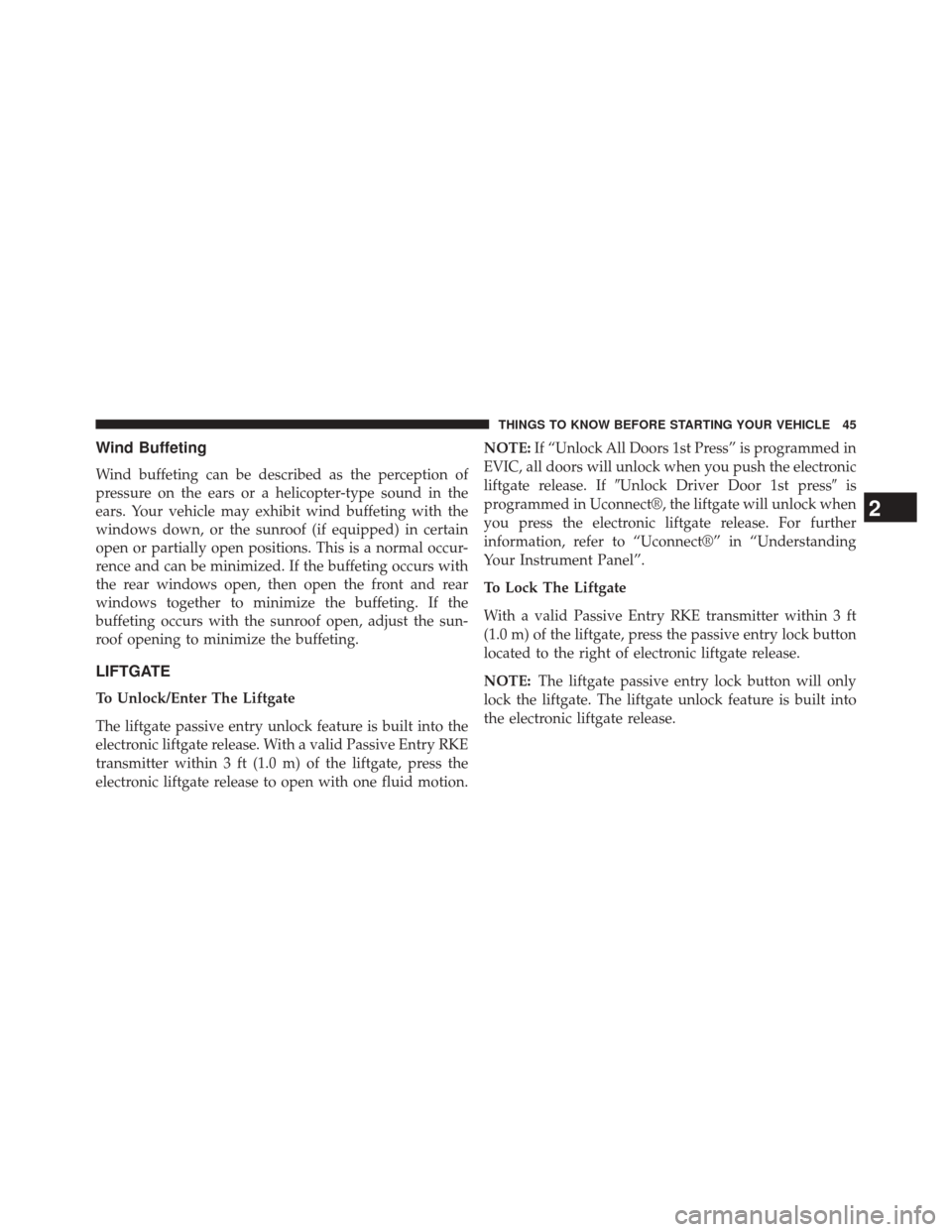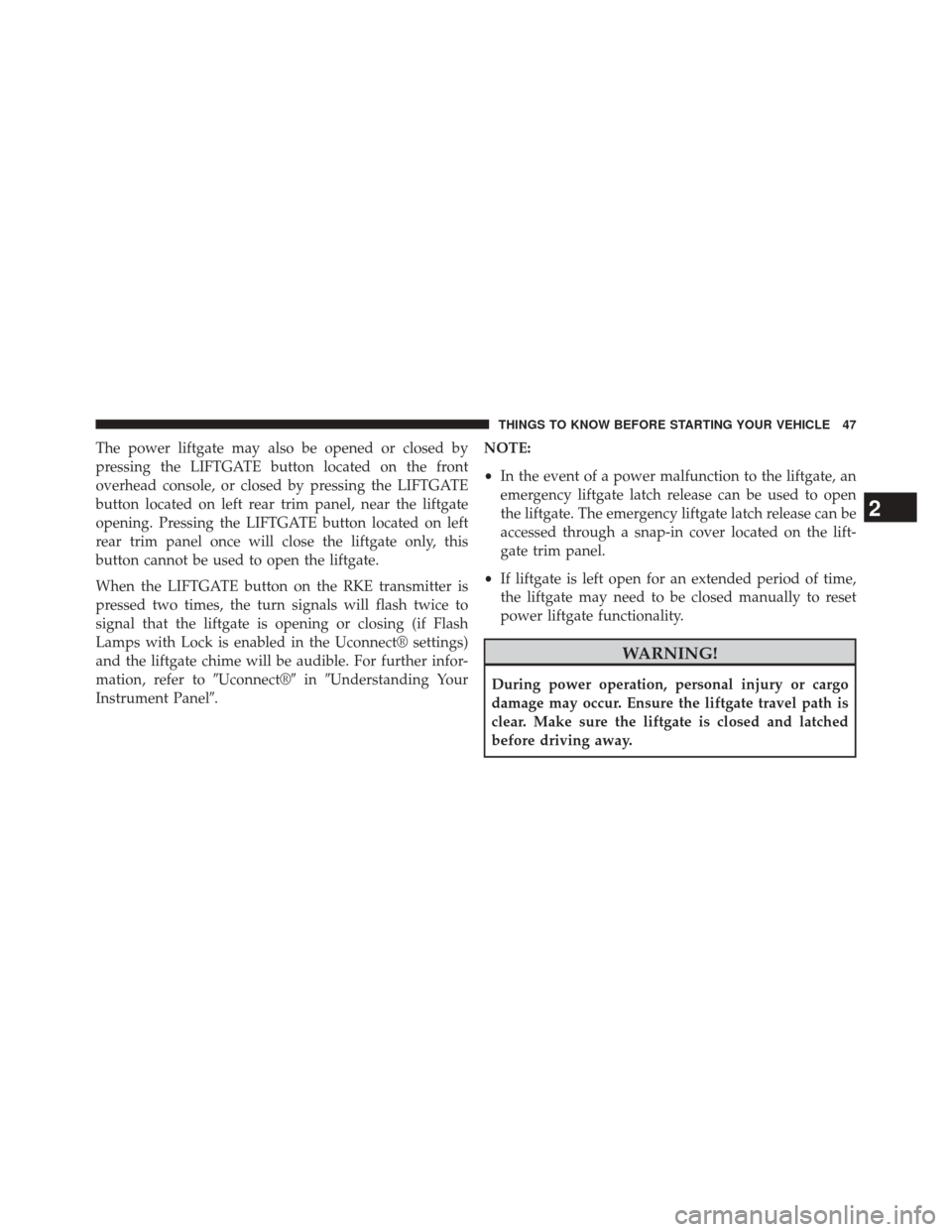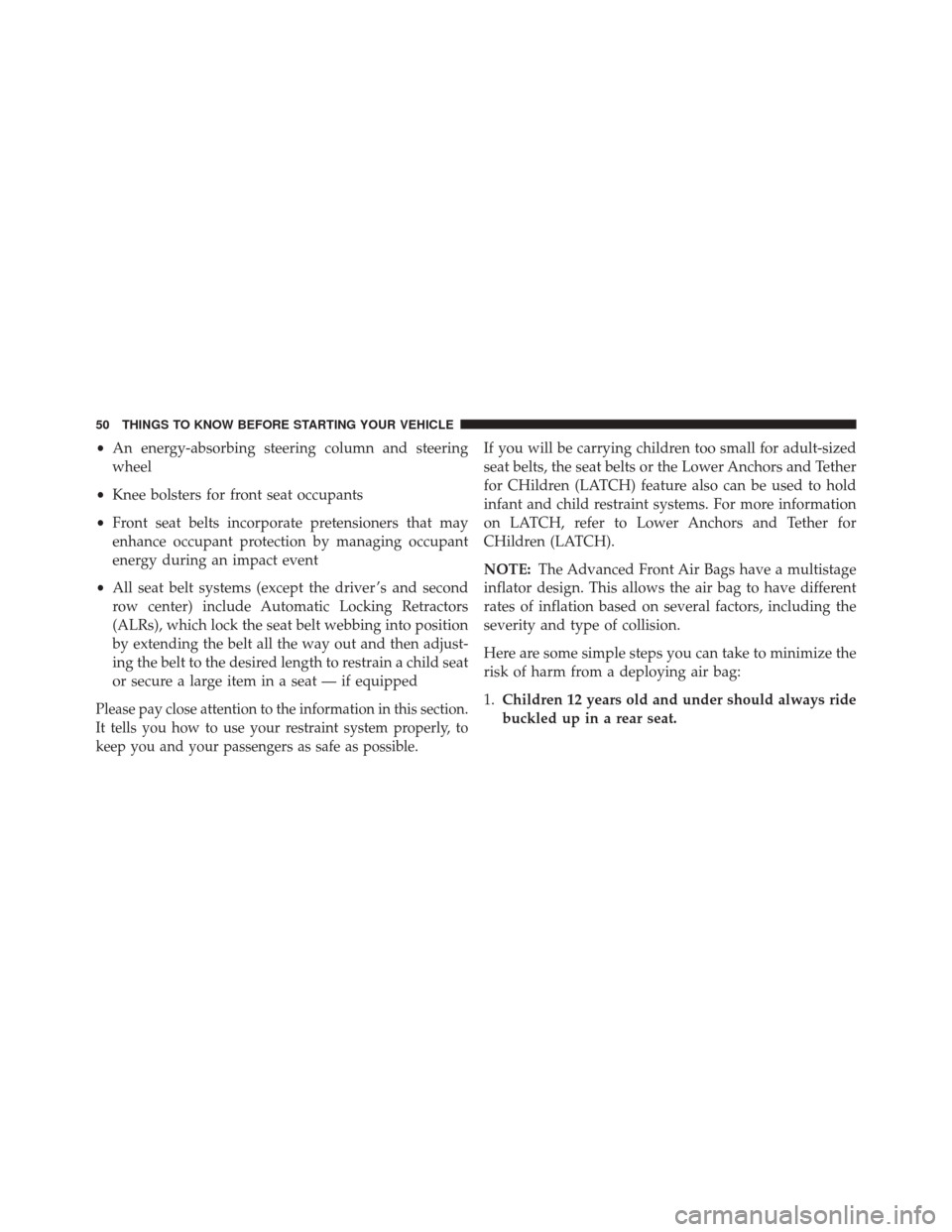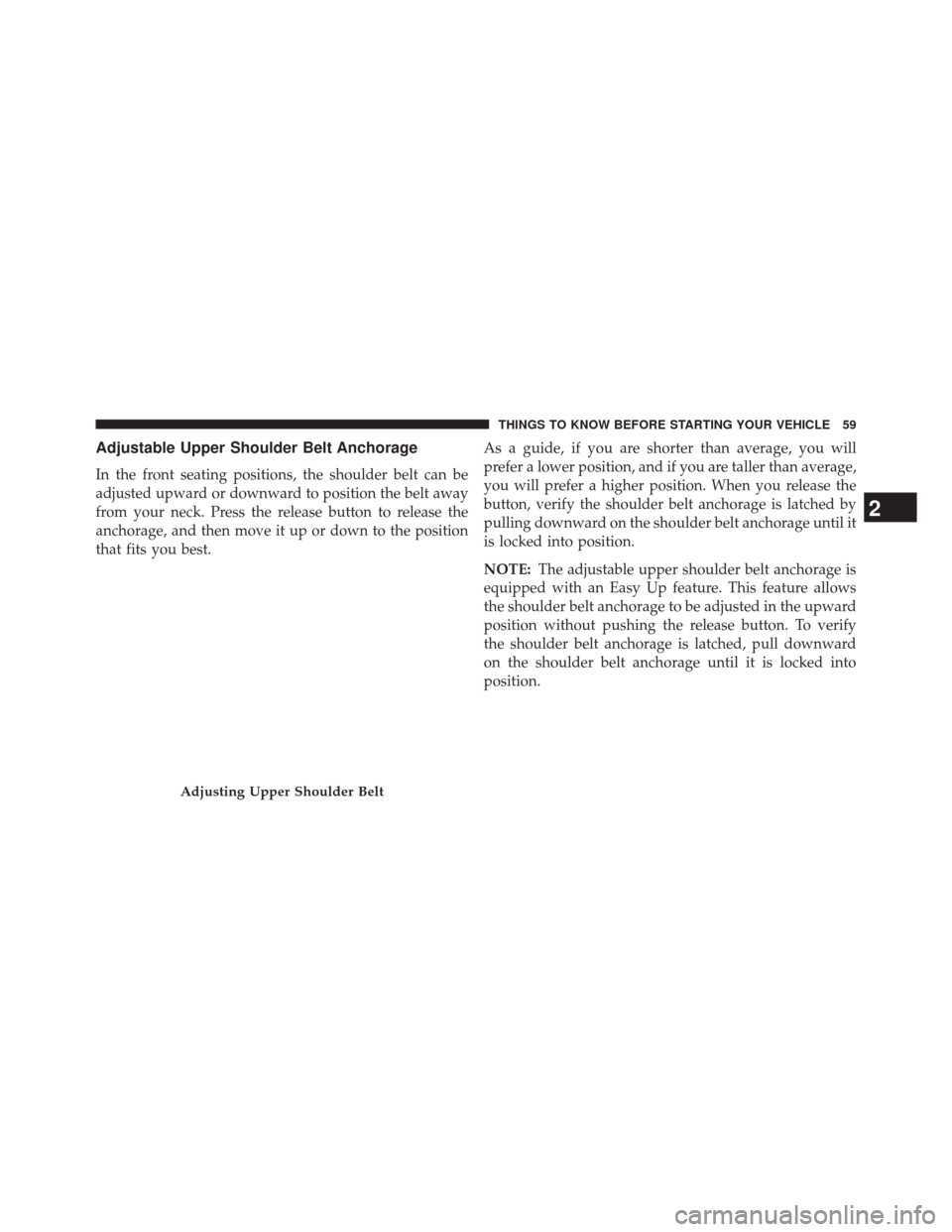Page 42 of 615
Do NOT grab the door handle, when pressing the door
handle lock button. This could unlock the door(s).NOTE:
•
After pressing the door handle LOCK button, you
must wait two seconds before you can lock or unlock
the doors, using either Passive Entry door handle. This
is done to allow you to check if the vehicle is locked by
pulling the door handle, without the vehicle reacting
and unlocking.
• The Passive Entry system will not operate if the RKE
transmitter battery is dead.
The vehicle doors can also be locked by using the RKE
transmitter lock button or the lock button located on the
vehicle’s interior door panel.
Do NOT Grab The Door Handle When Locking
40 THINGS TO KNOW BEFORE STARTING YOUR VEHICLE
Page 46 of 615
WARNING!
There is no anti-pinch protection when the window
is almost closed. Be sure to clear all objects from the
window before closing.
Resetting The Auto Up Feature
Should the Auto Up feature stop working, the window
probably needs to be reset. To reset Auto Up:
1. Pull the window switch up to close the windowcompletely and continue to hold the switch up for an
additional two seconds after the window is closed.
2. Push the window switch down firmly to the second detent to open the window completely and continue
to hold the switch down for an additional two seconds
after the window is fully open.
Window Lockout Button
The Window Lockout button on the driver’s door allows
you to disable the window controls on the rear doors. To
disable the window controls on the rear doors, push the
Window Lockout button. To enable the window controls,
push the Window Lockout button again.
Window Lockout Button
44 THINGS TO KNOW BEFORE STARTING YOUR VEHICLE
Page 47 of 615

Wind Buffeting
Wind buffeting can be described as the perception of
pressure on the ears or a helicopter-type sound in the
ears. Your vehicle may exhibit wind buffeting with the
windows down, or the sunroof (if equipped) in certain
open or partially open positions. This is a normal occur-
rence and can be minimized. If the buffeting occurs with
the rear windows open, then open the front and rear
windows together to minimize the buffeting. If the
buffeting occurs with the sunroof open, adjust the sun-
roof opening to minimize the buffeting.
LIFTGATE
To Unlock/Enter The Liftgate
The liftgate passive entry unlock feature is built into the
electronic liftgate release. With a valid Passive Entry RKE
transmitter within 3 ft (1.0 m) of the liftgate, press the
electronic liftgate release to open with one fluid motion.NOTE:
If “Unlock All Doors 1st Press” is programmed in
EVIC, all doors will unlock when you push the electronic
liftgate release. If �Unlock Driver Door 1st press� is
programmed in Uconnect®, the liftgate will unlock when
you press the electronic liftgate release. For further
information, refer to “Uconnect®” in “Understanding
Your Instrument Panel”.
To Lock The Liftgate
With a valid Passive Entry RKE transmitter within 3 ft
(1.0 m) of the liftgate, press the passive entry lock button
located to the right of electronic liftgate release.
NOTE: The liftgate passive entry lock button will only
lock the liftgate. The liftgate unlock feature is built into
the electronic liftgate release.
2
THINGS TO KNOW BEFORE STARTING YOUR VEHICLE 45
Page 48 of 615
WARNING!
Driving with the liftgate open can allow poisonous
exhaust gases into your vehicle. You and your pas-
sengers could be injured by these fumes. Keep the
liftgate closed when you are operating the vehicle.
Power Liftgate — If Equipped
The power liftgate may be opened by pressing
the electronic liftgate release (refer to Keyless
Enter-N-Go™ located in Things To Know Be-
fore Starting) or by pressing the LIFTGATE
button on the Remote Keyless Entry (RKE) transmitter.
Press the LIFTGATE button on the RKE transmitter twice
within five seconds, to open the power liftgate. Once the
liftgate is open, pressing the button twice within five
seconds a second time will close the liftgate.
Passive Entry/Lock Button Location
1 — Electronic Liftgate Release 2 — Lock Button Location
46 THINGS TO KNOW BEFORE STARTING YOUR VEHICLE
Page 49 of 615

The power liftgate may also be opened or closed by
pressing the LIFTGATE button located on the front
overhead console, or closed by pressing the LIFTGATE
button located on left rear trim panel, near the liftgate
opening. Pressing the LIFTGATE button located on left
rear trim panel once will close the liftgate only, this
button cannot be used to open the liftgate.
When the LIFTGATE button on the RKE transmitter is
pressed two times, the turn signals will flash twice to
signal that the liftgate is opening or closing (if Flash
Lamps with Lock is enabled in the Uconnect® settings)
and the liftgate chime will be audible. For further infor-
mation, refer to�Uconnect®�in�Understanding Your
Instrument Panel�. NOTE:
•
In the event of a power malfunction to the liftgate, an
emergency liftgate latch release can be used to open
the liftgate. The emergency liftgate latch release can be
accessed through a snap-in cover located on the lift-
gate trim panel.
• If liftgate is left open for an extended period of time,
the liftgate may need to be closed manually to reset
power liftgate functionality.
WARNING!
During power operation, personal injury or cargo
damage may occur. Ensure the liftgate travel path is
clear. Make sure the liftgate is closed and latched
before driving away.
2
THINGS TO KNOW BEFORE STARTING YOUR VEHICLE 47
Page 52 of 615

•An energy-absorbing steering column and steering
wheel
• Knee bolsters for front seat occupants
• Front seat belts incorporate pretensioners that may
enhance occupant protection by managing occupant
energy during an impact event
• All seat belt systems (except the driver ’s and second
row center) include Automatic Locking Retractors
(ALRs), which lock the seat belt webbing into position
by extending the belt all the way out and then adjust-
ing the belt to the desired length to restrain a child seat
or secure a large item in a seat — if equipped
Please pay close attention to the information in this section.
It tells you how to use your restraint system properly, to
keep you and your passengers as safe as possible.
If you will be carrying children too small for adult-sized
seat belts, the seat belts or the Lower Anchors and Tether
for CHildren (LATCH) feature also can be used to hold
infant and child restraint systems. For more information
on LATCH, refer to Lower Anchors and Tether for
CHildren (LATCH).
NOTE: The Advanced Front Air Bags have a multistage
inflator design. This allows the air bag to have different
rates of inflation based on several factors, including the
severity and type of collision.
Here are some simple steps you can take to minimize the
risk of harm from a deploying air bag:
1. Children 12 years old and under should always ride
buckled up in a rear seat.
50 THINGS TO KNOW BEFORE STARTING YOUR VEHICLE
Page 55 of 615

Buckle up even though you are an excellent driver, even
on short trips. Someone on the road may be a poor driver
and cause a collision that includes you. This can happen
far away from home or on your own street.
Research has shown that seat belts save lives, and they
can reduce the seriousness of injuries in a collision. Some
of the worst injuries happen when people are thrown
from the vehicle. Seat belts reduce the possibility of
ejection and the risk of injury caused by striking the
inside of the vehicle. Everyone in a motor vehicle should
be belted at all times.
Lap/Shoulder Belts
All seating positions in your vehicle are equipped with
lap/shoulder belts. The belt webbing retractor is de-
signed to lock during very sudden stops or collisions.
This feature allows the shoulder part of the belt to movefreely with you under normal conditions. However, in an
collision the belt will lock and reduce the risk of you
striking the inside of the vehicle or being thrown out.
WARNING!
•
Wearing a seat belt incorrectly is dangerous. Seat
belts are designed to go around the large bones of
your body. These are the strongest parts of your
body and can take the forces of a collision the best.
Wearing your belt in the wrong place could make
your injuries in a collision much worse. You might
suffer internal injuries, or you could even slide out
of part of the belt. Follow these instructions to wear
your seat belt safely and to keep your passengers
safe, too.
(Continued)
2
THINGS TO KNOW BEFORE STARTING YOUR VEHICLE 53
Page 61 of 615

Adjustable Upper Shoulder Belt Anchorage
In the front seating positions, the shoulder belt can be
adjusted upward or downward to position the belt away
from your neck. Press the release button to release the
anchorage, and then move it up or down to the position
that fits you best.As a guide, if you are shorter than average, you will
prefer a lower position, and if you are taller than average,
you will prefer a higher position. When you release the
button, verify the shoulder belt anchorage is latched by
pulling downward on the shoulder belt anchorage until it
is locked into position.
NOTE:
The adjustable upper shoulder belt anchorage is
equipped with an Easy Up feature. This feature allows
the shoulder belt anchorage to be adjusted in the upward
position without pushing the release button. To verify
the shoulder belt anchorage is latched, pull downward
on the shoulder belt anchorage until it is locked into
position.
Adjusting Upper Shoulder Belt
2
THINGS TO KNOW BEFORE STARTING YOUR VEHICLE 59